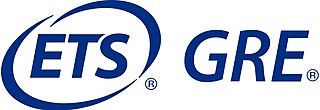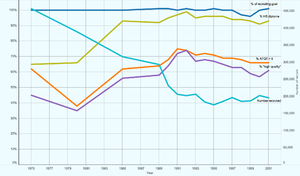
The Graduate Management Admission Test is a computer adaptive test (CAT) intended to assess certain analytical, writing, quantitative, verbal, and reading skills in written English for use in admission to a graduate management program, such as a Master of Business Administration (MBA) program. Answering the test questions requires knowledge of English grammatical rules, reading comprehension, and mathematical skills such as arithmetic, algebra, and geometry. The Graduate Management Admission Council (GMAC) owns and operates the test, and states that the GMAT assesses analytical writing and problem-solving abilities while also addressing data sufficiency, logic, and critical reasoning skills that it believes to be vital to real-world business and management success. It can be taken up to five times a year but no more than eight times total. Attempts must be at least 16 days apart.

The Graduate Record Examinations (GRE) is a standardized test that is part of the admissions process for many graduate schools in the United States and Canada and a few other countries. The GRE is owned and administered by Educational Testing Service (ETS). The test was established in 1936 by the Carnegie Foundation for the Advancement of Teaching.

The Law School Admission Test is a standardized test administered by the Law School Admission Council (LSAC) for prospective law school candidates. It is designed to assess reading comprehension, analytical reasoning, and logical reasoning. The test is an integral part of the law school admission process in the United States, Canada, the University of Melbourne, Australia, and a growing number of other countries.
The Common Admission Test (CAT) is a computer based test for admission in graduate management programs. The test consists of three sections: Verbal Ability and Reading Comprehension, Data Interpretation and Logical Reasoning and Quantitative Ability.The exam is taken online over a period of three hours, with one hour per section. In 2020, due to the COVID precautions, The Indian Institutes of Management Indore decided to conduct the CAT Exam in 2 hours with 40 minutes devoted to each section. The Indian Institutes of Management started this exam and use the test for selecting students for their business administration programs. The test is conducted every year by one of the Indian Institutes of Managements based on a policy of rotation.
The Swedish Scholastic Aptitude Test (SweSAT)(Swedish: högskoleprovet) is a standardised test used as one of the means to gain admission to higher education in Sweden. The test itself, which is administered by the Swedish Council for Higher Education, is divided into a mathematical part and a verbal part, which both respectively contain 4 subdivisions, in total 160 multiple-choice questions. All sections are taken in one day, a Saturday in April or a Sunday in October, lasting between 7½ and 8 hours including breaks between each section and a lunch break. Apart from the English language reading comprehension test, all sections are taken in Swedish.

The United States Military Entrance Processing Command (USMEPCOM) is a Major Command of the U.S. Department of Defense, which primarily screens and processes enlisted personnel applicants into the United States Armed Forces.
The Defense Language Aptitude Battery (DLAB) is a test used by the United States Department of Defense to test an individual's potential for learning a foreign language and thus determining who may pursue training as a military linguist. It consists of 126 multiple-choice questions and the test is scored out of a possible 164 points. The test is composed of five audio sections and one visual section. As of 2009, the test is completely web-based. The test does not attempt to gauge a person's fluency in a given language, but rather to determine their ability to learn a language. The test will give the service member examples of what a selection of words or what a portion of a word means, then asks the test taker to create a specific word from the samples given.
The Secondary School Admission Test (SSAT) is an admission test administered by The Enrollment Management Association in the United States to students in grades 3–11 to provide a standardized measure that will help professionals in independent or private elementary, middle, and high schools to make decisions regarding student test taking.
The Dental Admission Test is a multiple-choice standardized exam taken by potential dental school students in the United States and Canada. The DAT is a computer based test that can be administered almost any day of the year. Tests are taken at Prometric testing centers throughout the United States after the preliminary application through the American Dental Association is completed. Each applicant may only take the test a total of three times before having to ask special permission to take the exam again. After taking the exam, applicants must wait 90 days before repeating it. Each exam costs $495, all of which is non-refundable.
The GRE Literature in English Test was a standardized test administered by the Educational Testing Service. It was intended to evaluate applicants seeking admission to a graduate program in English Studies. The test surveyed a wide range of topics related to literature in English, but the focus was mainly on works long accepted as part of the canon.

Electrician's Mate is a United States Navy and United States Coast Guard occupational rating. The Electrician's Mate's NOS is B210.
The Army General Classification Test (AGCT) has a long history that runs parallel with research and means for attempting the assessment of intelligence or other abilities.
The Psychometric Entrance Test (PET) – commonly known in Hebrew as "ha-Psikhometri" – is a standardized test that serves as an entrance exam for institutions of higher education in Israel. The PET covers three areas: quantitative reasoning, verbal reasoning and English language. It is administered by the National Institute for Testing and Evaluation (NITE) and plays a considerable role in the admissions process. A score combining students' performance on the PET with the average score of their high school matriculation tests has been found to be a highly predictive indicator of students' academic performance in their first year of higher education.

The ICFESexamination, or Saber 11, is a high school exit examination administered annually in grade 11 in Colombian high schools. The exam is standardized, similar to the SAT and ACT examinations taken by high school students in the United States. The purpose of the exam is to evaluate students' aptitude in five subjects: critical reading, mathematics, social studies, science, and English. Each exam question has four multiple-choice answers, except for the English section which provides between three and eight possible answers for each question.
Project 100,000, also known as McNamara's 100,000, McNamara's Folly, McNamara's Morons, and McNamara's Misfits, was a controversial 1960s program by the United States Department of Defense (DoD) to recruit soldiers who would previously have been below military mental or medical standards. Project 100,000 was initiated by Defense Secretary Robert McNamara in October 1966 to meet the escalating workforce requirements of the American government's involvement in the Vietnam War. According to Hamilton Gregory, author of the book McNamara's Folly: The Use of Low-IQ Troops in the Vietnam War, inductees of the project died at three times the rate of other Americans serving in Vietnam and following their service had lower incomes and higher rates of divorce than their non-veteran counterparts. The project was ended in December 1971.
The Optometry Admission Test (OAT) is a test used to determine applicants' qualification for admission to a school of optometry. All colleges of optometry in the United States and the University of Waterloo in Canada use scores from the exam, in addition to work done at the undergraduate level of study, to decide whether to accept candidates. The test is administered by the American Dental Association (ADA) on behalf of the Association of Schools and Colleges of Optometry (ASCO).
According to Paul Muchinsky in his textbook Psychology Applied to Work, "mechanical aptitude tests require a person to recognize which mechanical principle is suggested by a test item." The underlying concepts measured by these items include sounds and heat conduction, velocity, gravity, and force.
The International Medical Admissions Test (IMAT), is an aptitude test used as part of the admissions process for some Italian universities. These universities offer undergraduate courses that are taught in English and open to applicants outside of Italy. The test has sometimes been incorrectly referred to as the 'Italian Medical Admissions Test'.

Marine Science Technician (MST) is an enlisted rate in the United States Coast Guard. They are specialists in enforcing Federal Maritime Laws for Marine Safety, Marine Security, and Environmental Protection.
The Policy Aptitude Test (PAT) is an offline written test held in India. This test scores a person on the bases of General Knowledge, Numerical Problem Solving, Policy Aptitude, Logical Reasoning, English Language and Policy Analysis Ability. The National Law School of India University, Bengaluru (NLSIU) started this exam and use the test for selecting students for its Public Policy Programme. The test is conducted every year.







